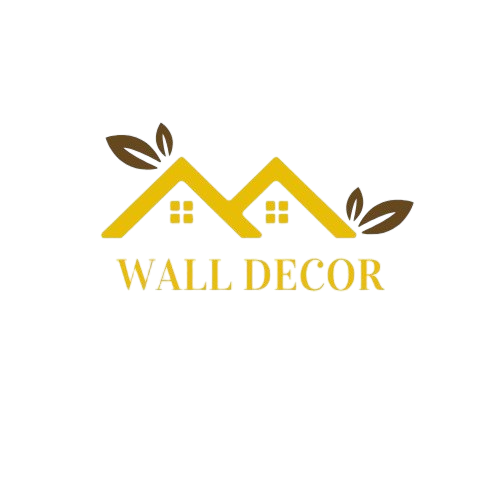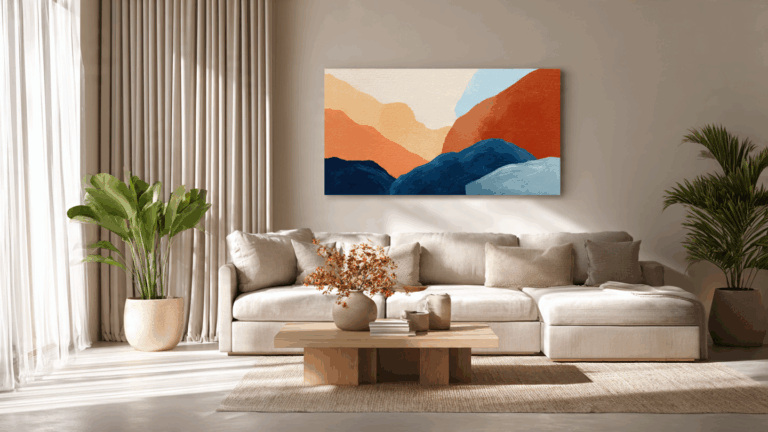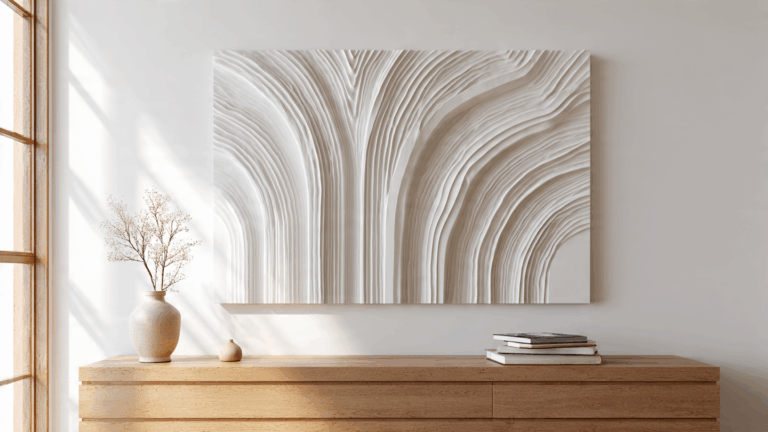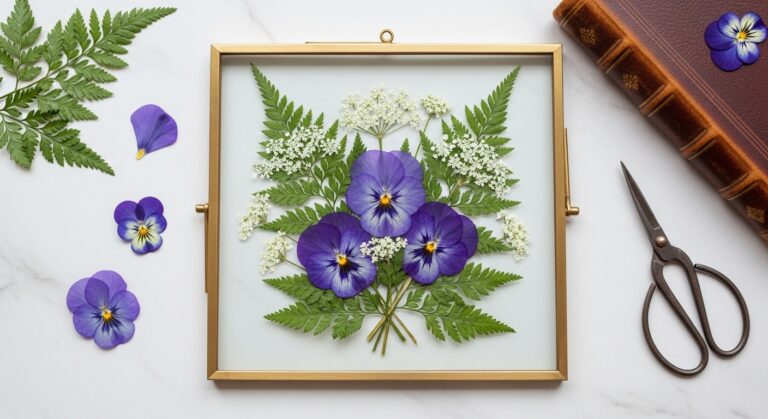That Giant Blank Wall is Staring at You, Isn’t It? Here’s How to Fill It for Cheap
That giant, empty wall in your living room or bedroom holds so much potential. It could be a stunning focal point, a conversation starter, a piece that ties the entire room together. But when you start browsing for oversized art online, the price tags—often running into hundreds or even thousands of dollars—can be shocking.DIY Wall Art
Don’t despair! You don’t need a massive budget to make a massive impact. In my experience decorating homes on a dime, the most impressive pieces are often the ones you create yourself.
This guide will walk you through exactly how to make large scale wall art on a budget. We’re talking show-stopping, oversized pieces that look like they came from a high-end gallery but cost you less than a night out.
Key Takeaways
Don’t have time to read everything? Here’s the short version:
- Go Abstract: You don’t need to be an artist. Large abstract paintings are forgiving and incredibly stylish.
- Think Beyond Canvas: Use unexpected materials like fabric, tapestries, or even engineering prints from a print shop.
- Upcycle & Thrift: A large piece of plywood or a thrifted frame can become the base for your masterpiece.
- Split It Up: Use multiple smaller canvases (a diptych or triptych) to create one large, cohesive piece.
- Frame Smart: A simple DIY wood frame makes any art look 100x more professional and expensive.
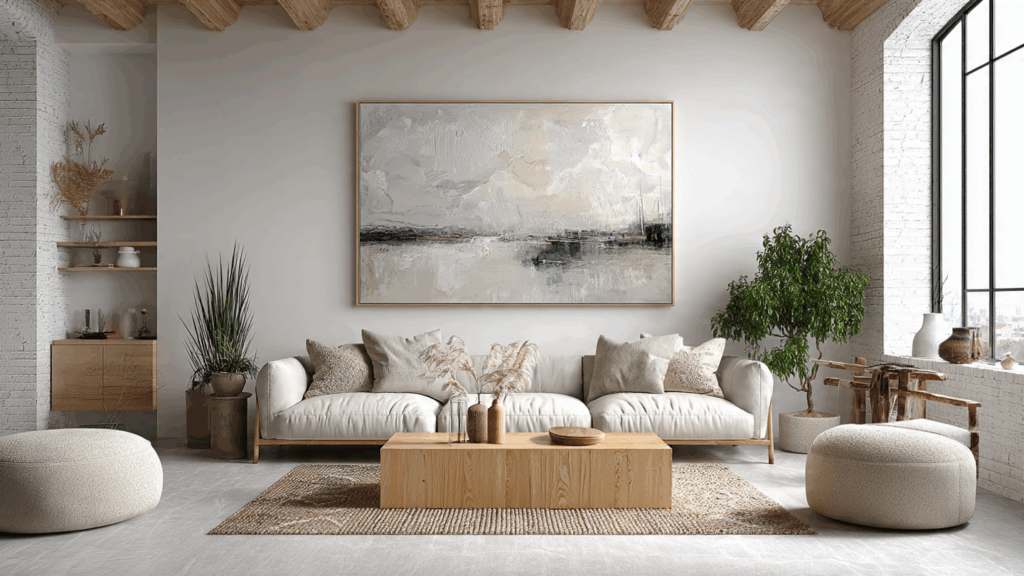
Why Bother with DIY Large Scale Art?
Before we dive into the “how,” let’s talk about the “why.”
- Massive Cost Savings: This is the big one. A custom 48″ x 60″ piece of art can easily cost over $500. You can create something of the same size and impact for under $75.
- Perfect Personalization: You get to choose the exact colors, style, and size to perfectly match your room’s decor. No more “almost perfect” compromises.
- The Bragging Rights: There’s an incredible sense of pride that comes from saying, “Thanks, I made it myself!” when a guest compliments your stunning artwork.
Your Budget-Friendly Arsenal: Gathering Supplies
The secret to affordable art is using simple, accessible materials. You don’t need professional-grade supplies to get a professional-grade look.
- The “Canvas”:
- A large, pre-stretched canvas (wait for a 50% off sale at a craft store!).
- A painter’s drop cloth from a hardware store (cheap and has a great texture).
- A large piece of plywood or MDF.
- A thrifted piece of art you can paint over.
- The Paint & Tools:
- Basic acrylic craft paints or even leftover wall paint samples.
- Wide paint brushes, a paint roller, or a plastic putty knife for creating texture.
5 Genius Methods for DIY Large Scale Wall Art
Here are my five favorite, tried-and-true methods that deliver incredible results without needing any artistic skill.
Method 1: The Go-To Abstract Canvas
This is the classic for a reason. It’s almost impossible to mess up, and the result is always chic and modern.
- Choose a Palette: Pick 3-4 colors that match your room. I recommend two neutrals (like beige and white), one primary color (like navy blue), and one metallic accent (like gold).
- Create a Base: Cover the entire canvas with your main neutral color. Let it dry completely.
- Add Layers: Using a large brush or a putty knife, add blocks and swooshes of your other colors. Don’t overthink it! The goal is to create organic shapes and texture.
- Blend and Soften: While the paint is still a bit wet, use a clean, dry brush to gently blend the edges where different colors meet. This creates a softer, more professional look.
- The Final Flourish: Once dry, add a few small, deliberate strokes of your metallic accent paint. What I’ve found works best is adding just a touch—it catches the light beautifully.
Method 2: The Engineering Print Power Move
This is my favorite budget hack of all time. An engineering print (or blueprint) from a place like Staples or a local print shop is a giant black-and-white print on thin paper that costs just a few dollars.
- Find an Image: Choose a high-resolution public domain photo. Think landscapes, architectural shots, or vintage portraits. The New York Public Library Digital Collections is a fantastic, high-authority resource for this.
- Get it Printed: Order a 36″ x 48″ (or larger) engineering print. It should only cost you around $5-$10.
- Mount It: Use a spray adhesive to carefully mount the print onto a thin board of foam core or MDF to give it structure.
- Frame It: Build a simple pine frame around it. This final step takes it from a poster to a legitimate piece of art.
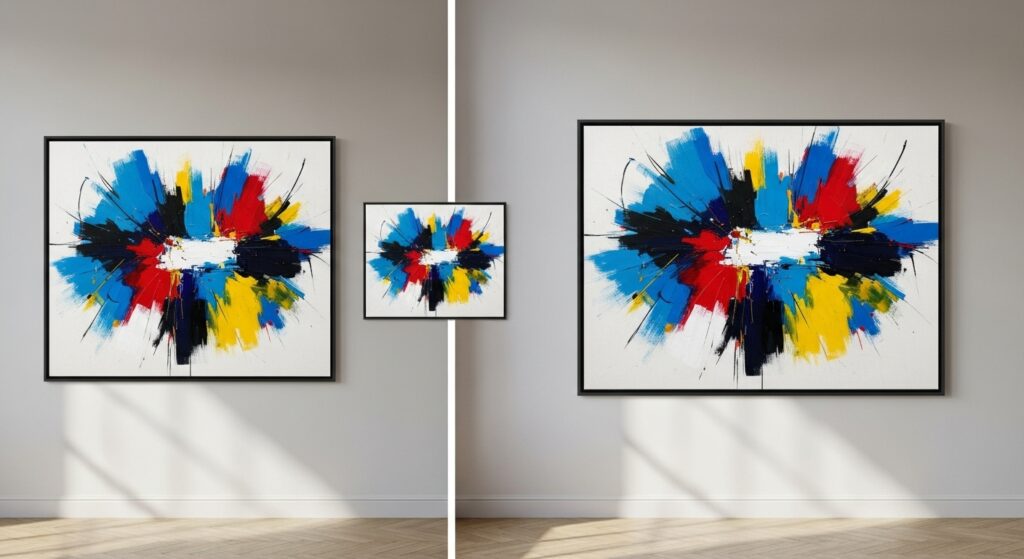
Method 3: The Elegant Fabric or Tapestry Hanging
- Select Your Fabric: Find a beautiful shower curtain, a lightweight rug, or a few yards of fabric with a pattern you love.
- Create a Hanger: The easiest way is to fold over the top edge of the fabric by two inches and sew a simple seam, leaving the ends open to create a pocket.
- Hang It: Slide a thin wooden dowel through the pocket and hang it on the wall from two nails or hooks. It’s that simple!
Method 4: The Split Canvas (Diptych/Triptych) Trick
Want a huge look without handling a single, giant canvas? Create a diptych (two panels) or triptych (three panels).
- Get Multiple Canvases: Buy 2 or 3 identical medium-sized canvases (e.g., 24″ x 30″).
- Create a Continuous Design: Lay them side-by-side on the floor with a tiny gap between them.
- Paint Across: Create a single abstract design that flows across all the canvases as if they were one.
- Hang with Precision: When you hang them on the wall, leave a 1-2 inch gap between each panel. This creates a high-end, gallery-style look that gives the illusion of a much larger single piece.
Method 5: The Upcycled Plywood Statement Piece
For a more rustic, modern farmhouse, or industrial vibe, plywood is your best friend.
- Source Your Wood: Get a large sheet of smooth, sanded plywood from a hardware store.
- Stain or Paint: Apply a wood stain for a natural look, or create a geometric design using painter’s tape and two different colors of paint.
- Frame It (Optional): Attach simple 1×2″ lumber around the edges to create a clean, finished frame.
- Mount Securely: This piece will be heavy, so make sure you use proper wall anchors or screw it directly into wall studs. A guide on this can be found in our post [Link to: The Ultimate Guide to Hanging Heavy Wall Decor].
Conclusion
Creating stunning, large scale wall art doesn’t require a trust fund or an art degree. All it takes is a little creativity, some basic materials, and the confidence to try something new. You can fill that empty wall and transform your space into something that is uniquely you.
Frequently Asked Questions (FAQ)
Q: What is the absolute cheapest way to make large wall art? A: The cheapest method is definitely the Engineering Print. You can get a massive 3-foot by 4-foot print for under $10 and mount it on foam core. It delivers the biggest impact for the lowest cost.
Q: Can I use a bedsheet or shower curtain for fabric wall art? A: Absolutely! Many modern shower curtains and flat sheets have beautiful, large-scale patterns that are perfect for this project. It’s one of the best ways to find a huge piece of patterned fabric for cheap.
Q: I’m not artistic at all. Which project is the most foolproof? A: The fabric/tapestry hanging is the most foolproof, as it requires no painting or design skills. The second easiest would be the abstract canvas, because there are no rules and you can’t really make a “mistake.” Just focus on colors you love.
Q: How do I make my DIY art look expensive? A: The secret is in the finishing. Adding a simple, clean frame (either DIY or a cheap poster frame) instantly elevates any piece. Also, make sure your color palette is intentional and complements the rest of your room’s decor. Our guide on [Link to: Choosing the Perfect Color Palette for Your Home] can help with that.
